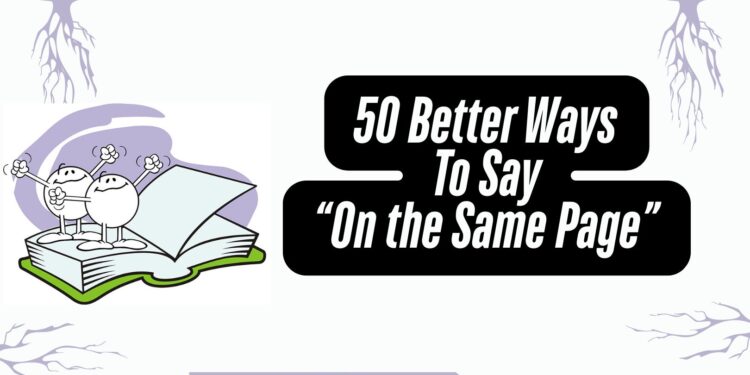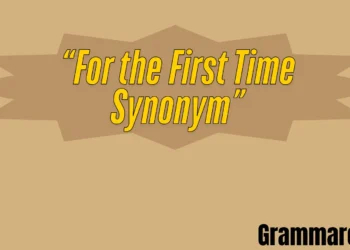Expressing common knowledge or consent facilitates teamwork and communication with others. Though many use the phrase on the same page, there are many other ways to convey this idea—often with more subtlety or a more personalized tone depending on the situation.
Well-chosen replacements can help you to relate more clearly and significantly, and so advance your language skills. Below are 50 different ways to articulate alignment—whether in a personal chat, a business setting, or a casual conversation.
What does “on the same page” mean?
The phrase “on the same page” is a metaphor to express a shared agreement or understanding among people. It suggests that everyone participating is either thinking alike, holding the same expectations, or on course for a shared goal. This phrase highlights the importance of harmony and transparency in project planning, interpersonal connections, and team meetings. It is occasionally employed to avoid misinterpretations by confirming that everyone sees the topic or tactic equally.
Is it polite/professional to say “on the same page”?
On the same page, really, is perceived as both professional and courteous. It is frequently used in informal conversations, corporate emails, and business meetings, as it conveys a pleasant yet intentional attitude. The line shows you have a collaborative mindset and value teamwork and mutual understanding. Although it is often valued, bear in mind the situations; very formal or academic situations may call for more specific alternatives, such as agreement or alignment.
Pros and cons of using “On the Same Page”
Pros
Encourages group effort and common understanding.
Easier to say and generally acknowledged.
Direct language in feedback or clarification is softened.
Works in both written and verbal communication.
Promotes alignment without coming off aggressive.
Cons
In workplace terminology, one can feel overworked.
Too informal for legal or scholarly writing.
May lack accuracy in difficult or technical situations.
Not always easy without further explanation.
Could not accurately convert in multicultural or multilingual contexts.
When to use “On the Same Page”?
Before making a major decision, during a team debate, or after presenting critical information, use “on the same page” to ensure agreement or a common understanding. Verifying that everyone understands instructions, schedules, or expectations is beneficial for this purpose. Whether spoken or written, it adds a human, considerate touch to ensure everyone is aligned without sounding demanding or too formal.
What tone does “On the Same Page” have?
This statement has a welcoming, collaborative, inclusive tone. Its adaptability in both professional and social situations comes from neither being too hard nor being extremely laid-back. It conveys your regard for their ideas and comprehension. Its cooperative nature makes it very successful in customer communication, leadership, and teamwork—areas where clarity and collaboration are critical.
When Should You Avoid This “On the Same Page”?
Avoid employing this expression in extremely formal writing like scientific papers, legal briefs, or academic research, where more technical or precise language is sought. Moreover, if you have already used it several times in the same document or chat, refrain from using it—it may sound repetitive or lose its effectiveness. Consider a more exact replacement if your audience is not fluent in English to prevent misinterpretation.
Professional Alternatives of “on the same page”
1. Aligned with our knowledge
Meaning: We both see things similarly.
Definition: Shared understanding or grasp of a subject or circumstance.
Explanation: This expression implies both parties have an exact, shared knowledge of the subject being covered.
Example: I would like to confirm that we share a common understanding of the client’s objectives before proceeding.
Best Use: Performance reviews, project kicks, team meetings.
Worst Use: Formal in both everyday and casual conversations.
Tone: Professional, thoughtful tone.
2. Agreeing
Both of us agree on the same idea.
Definition: A mutual level of agreement or acceptance.
Explanation: This straightforward statement highlights how two sides have reached an agreement or share a common view.
Example: It seems we have a consensus on the timeline.
Best Use: Formal approvals and decision-making.
Worst Use: If the conversation is continuing, it may come across as too conclusive.
Tone: Definitive, straightforward.
3. Collaborating under the same presuppositions
Meaning: Our actions follow from agreed-upon ideas or expectations.
Definition: Acting based on commonly accepted starting points or conditions.
Explanation: Highlights that everyone is operating under the same fundamental principles.
Example: Are we starting from the same budget-limiting assumptions?
Best Use: Planning sessions, strategy sessions.
Worst Use: Casual discussions could come off as too analytical.
Tone: Analytical, constructive.
4. In rhythm
Meaning: Our actions or thoughts are coordinated.
Definition: Harmoniously coordinated or lined.
Explanation: Often used to characterize perfect collaboration or similar attitudes.
Example: “We agree on this—let’s press forward.”
Best Use: Creative teamwork, casual updates.
Worst Use: Highly technical documents could sound too casual.
Tone: Friendly, upbeat, smooth.
5. Along with
Meaning: Plans or goals coincide.
Definition: Being in perfect arrangement or agreement.
Explanation: Suggested harmony in strategy, choices, or values.
Example: “Let’s see if we’re still matching our initial goals.”
Best Use: Leadership updates, project status reports.
Worst Use: One-on-one emotional dialogues.
Tone: Businesslike, structured, goal-oriented.
6. On target together
Meaning: We move in the same direction.
Definition: Moving toward a shared target or goal.
Explanation: Gives a sense of coordinated, continuous movement.
Example: “Having examined our progress, we are on track together.”
Best Use: Collaborative work, progress reports.
Worst Use: For arguments and emotional conversations.
Tone: Motivational, aligned, efficient.
7. Viewing things similarly
Meaning: Our opinions on the matter are comparable.
Definition: Sharing views or interpretations.
Explanation: Emphasis on cognitive or emotional alignment.
Example: “I’m happy we see this design strategy from the same angle.”
Best Use: Brainstorming, sympathetic discussions.
Worst Use: Negotiations where disagreements should be recognized.
Tone: Open, respectful, reflective.
8. Sharing perspective
Meaning: We understand the circumstances similarly.
Definition: Two-way comprehension of a circumstance or evaluation of one.
Explanation: Agreeing naturally but efficiently.
Example: “It seems as though we view next actions the same way.”
Best Use: Rapid checks; amicable cooperation.
Worst Use: Formal papers are the least beneficial use.
Tone: Familiar, conversational.
9. Reading from the same script
Meaning: We regularly present or interpret events.
Definition: Speaking or behaving identically in a united way.
Explanation: Often used to convey behavioral or message coordination.
Example: “When talking with the customer, we should be using the same script.”
Best Use: Sales alignment, public communications.
Worst Use: May appear formal or staged in everyday settings.
Tone: Planned, strategic.
10. Reasoning alike
Meaning: Our ideas are either alike or compatible.
Definition: Sharing a similar train of thought or logic.
Explanation: Shows an intuitive link in the thought process.
Example: “I was thinking along the same lines for the solution.”
Best Use: Idea generation and casual collaboration.
Worst Use: Legal or exceedingly formal writing.
Tone: Imaginative, relaxed, instinctive.
11. By means of clear understanding
Meaning: We both know very well.
Definition: A condition in which a confirmed and clear mutual understanding exists.
Explanation: Highlights the caliber of knowledge instead of simply its existence.
Example: “Let’s move ahead with agreed-upon roles.”
Best Use: Planning, role alignment, expectation setting.
Worst Use: Conversations that lack transparency or are marred by misunderstandings.
Tone: Exact, liberating.
12. In agreement with the scheme
Meaning: I am determined and согласен.
Definition: Absolutely sympathetic and matched to a suggested course of action.
Explanation: Expresses approval and active participation.
Example: “The plan to modify the timetable is one we all agree with.”
Best Use: Team buy-in moments, group decisions.
Worst Use: May come across as pushy if others are unsure of their intentions.
Tone: Energetic, confident.
13. Speaking the same language
Meaning: We are familiar with one another.
Definition: Communicating in a way both sides can understand.
Explanation: Urges easy and organic communication even among several roles or fields of expertise.
Example: “At last, marketing and technology are communicating in the same language!”
Best Use: Cross-functional cooperation.
Worst Use: Exceedingly literal scenarios.
Tone: Light, funny, culturally aware.
14. Heading in the same direction
Meaning: We’re after the same objective.
Definition: Stepping toward a shared Future situation.
Explanation: Signals cooperation in aim and subsequent activity.
Example: “Though our approaches may differ, we are going in the same direction.”
Best Use: Strategy meetings; long-range planning.
Worst Use: Deeply clarified conflict resolution.
Tone: Forward-looking, visionary.
15. Following the same approach
Meaning: We are applying the same approaches or frameworks.
Definition: Working on a common approach or plan.
Explanation: Often employed in cooperative or standardized settings, shows procedural agreement.
Example: “Both teams are testing in the same manner.”
Best Use: Process standardization; technical teams.
Worst Use: Creative brainstorming, where variety is sought.
Tone: Calculated, methodical.
16. Moving forward jointly
Meaning: As we approach the following steps, we come together.
Definition: Progressing in collaboration or with a common aim.
Explanation: Points toward shared dedication, collaboration, and progress.
Example: “Though we have had some hurdles, we now push forward together.”
Best Use: Change management, dispute resolution.
Worst Use: When agreement has not yet been reached.
Tone: Optimistic, inspiring, unifying.
17. Synchronized in our thought processes
Meaning: Our ideas are organized and match.
Definition: A common cognitive framework for tackling a problem.
Explanation: Shows careful, coordinated cooperation.
Example: In our approach to launching this, we are coordinating our efforts to ensure a seamless rollout.
Best Use: Cross-functional teams and planning committees.
Worst Use: Occasional chats or casual surroundings.
Tone: Professional and concentrated.
18. Founded on mutual knowledge
Meaning: A shared understanding defines our foundation.
Definition: Grounded in well-said and consensually known knowledge.
Explanation: Reflects solid, trust-based communication.
Example: “Mutual understanding and openness form the basis of our cooperation.”
Best Use: Partnerships, agreements, cooperation.
Worst Use: In regular conversation, it may seem excessively formal.
Tone: Genuine, respectful, basic.
19. In correspondence
Meaning: Everybody concurs on the decision or concept.
Definition: A collective position or decision among individuals.
Explanation: Wonderful for summarizing the agreement achieved following the debate.
Example: “Therefore, we all agree on the following actions?”
Best Use: Decision points, meeting summaries.
Worst Use: Early-stage brainstorming, where ideas are still in the development stage.
Tone: Neutral, clear, collaborative.
20. Working with the same assumptions
Meaning: We all begin with the same fundamental ideas.
Definition: Consensus on the basis of expectations.
Explanation: By making sure the underlying logic is shared, confusion is prevented.
Example: “Let’s confirm our work with the same assumptions regarding the timeline.”
Best Use: Strategy, scope definitions, meeting arrangements.
Worst Use: Informal or nontechnical interactions.
Tone: Deliberate, analytical, exact.
21. Tracking together with us
Meaning: Staying together.
Definition: Indicates concurrent development or continuing agreement.
Explanation: Used to guarantee that things are developing in harmony.
Example: “It seems as though we are tracking together on all the deliverables.”
Best Use: In progress checks or project management.
Worst Use: Miscommunication could distort the truth.
Tone: Supportive and process-driven.
22. Knowing things the same way
Meaning: Mutual understanding of an idea or decision.
Definition: Both sides see events the same way.
Explanation: Assures no divergent hypotheses exist.
Example: “Just checking—we’re seeing things the same way, right?”
Best Use: Before execution or in resolving arguments.
Worst Use: It may create tension among defensive or misaligned groups.
Tone: Careful and beneficial.
23. Together in this angle
Meaning: Viewing things from the same perspective or viewpoint.
Definition: Shows a coherent view or philosophy.
Explanation: Stresses how people or teams interpret a circumstance similarly.
Example: “We share this viewpoint on quality above speed.”
Best Use: During team visioning or vision statements.
Worst Use: Technical or metrics-driven discussions.
Tone: Reflective and harmonizing.
24. You and I are in sync.
Meaning: We’re thinking or acting in accord.
Definition: Smooth action or thought coordination.
Explanation: Affirms a pleasant and reciprocal communication rhythm.
Example: Looks like you and I see eye to eye on this method.
Best Use: One-on-one or peer discussions.
Worst Use: In official presentations, it might sound too casual.
Tone: Friendly and collaborative.
25. In accordance with
Meaning: We see agreement on route, aim, or understanding.
Definition: Alignment in priorities, goals, or viewpoints.
Explanation: Suggests conscious agreement following thought.
Example: “I’m happy our core message is aligned.”
Best Use: Leadership discussions, strategic planning.
Worst Use: For personal communications or in excessively informal settings.
Tone: Professional, assured.
26. On track together
Meaning: Developing along a unit’s path.
Definition: Moving along on a common plan and focus.
Explanation: Strengthens a common speed and dedication.
Example: “Sounds like we’re on track together—let’s keep the momentum going.”
Best Use: Updates on projects, progress checks.
Worst Use: Ambiguous or abstract scenarios with uncertain objectives.
Tone: Positive, action-oriented, inspirational.
27. Viewing things similarly
Meaning: Our views of the circumstances are alike.
Definition: Sharing a perspective.
Explanation: Acknowledges emotional or intellectual agreement.
Example: “Knowing we are viewing things similarly helps.”
Best Use: Conflict resolution, one-on-one syncs.
Worst Use: When divergent thinking is expected.
Tone: Empathetic, considerate, honest.
28. Viewing events in the same way
Meaning: Viewing the problem with comparable interpretation.
Definition: Concordance in viewpoint or judgment.
Explanation: Unofficial yet honest way of confirming knowledge.
Example: “Glad we see things the same way—it makes working together simpler.”
Best Use: Team meetings and casual conversations.
Worst Use: Overly formal papers or documentation.
Tone: Conversational, amicable, linking.
29. Considering similarly
Meaning: Having comparable trains of thought or ideas.
Definition: Shared brainstorm or cognitive alignment.
Explanation: Strengthening of shared creativity or logic.
Example: “We’re certainly thinking along the same lines on this design.”
Best Use: Creative projects and brainstorming sessions.
Worst Use: Formal decision-making statements.
Tone: Relaxed, encouraging, cooperative.
30. With mutual clarity
Meaning: Everyone sees the issue clearly and consistently.
Definition: Shared knowledge without uncertainty.
Explanation: Emphasizes how clarity has been attained collectively.
Example: “Let’s move with agreed clarity on next week’s objectives.”
Best Use: Post-discussion alignment, concluding remarks.
Worst Use: In unclear or investigative conversations.
Tone: Adult, collected, clear.
31. Agree with the strategy
Meaning: Ready to move and consistent with one another.
Definition: Signaling support and willingness.
Explanation: Common in team or leadership updates:
Example: “Seems everyone is on plan. Let’s advance.”
Best Use: Team meetings fueled by action and status reports.
Worst Use: Initial or confused phases of planning.
Tone: Confidence, direction, inclusivity.
32. Speaking the same language
Meaning: Quickly and precisely comprehending each other.
Definition: Talking devoid of misunderstanding or confusion.
Explanation: Very good when talking about communication styles or clarity.
Example: “We’re at long speaking the same language on deliverables.”
Best Use: For cross-functional or cross-cultural discussions.
Worst Use: Sensitive cultural themes or literal translations.
Tone: Light, humorous, relatable.
33. Along with you on this one,
Meaning: I stand with you or concur with your position.
Definition: Clearly and individually represents alignment.
Explanation: A quick, casual approach to demonstrate support or approval.
Example: “That timeline works—I’m with you on this.”
Best Use: In supportive communications or informal chats.
Worst Use: With unknown audiences or in official papers.
Tone: Supportive, laid-back, and friendly.
34. Let’s match up to prevent chaos.
Meaning: Encouraging clear understanding through clarification.
Definition: Implies coordination of expectations or concepts.
Explanation: A proactive strategy to avoid misinterpretation.
Example: “Let’s align to avoid confusion before kickoff.”
Best Use: During decision-making phases or preparation.
Worst Use: Mid-conflict could come off excessively instructive.
Tone: Preventive and cooperative.
35. Developing understanding with others
Meaning: Together striving for knowledge.
Definition: Working together toward mutual clarity.
Explanation: It advises collaboration in resolving complex or uncertain situations.
Example: “We’re clarifying together; that is advancement.”
Best Use: Early phases of projects or idea creation.
Worst Use: In situations requiring rapid decision-making.
Tone: Cooperative and patient.
36. Entered together thoughtfully
Meaning: Possessing the same opinions or viewpoint.
Definition: Thinking similarly either in purpose or in outlook.
Explanation: This poetic sentence stresses intellectual or mental harmony.
Example: “It’s nice to feel joined in thought on this big decision.”
Best Use: With trusted partners or in reflective conversations.
Worst Use: Rapid, high-stakes corporate environment.
Tone: Reflective, thoughtful, and warm.
37. Traveling ahead together
Meaning: Working together in steps.
Definition: Moving ahead in harmony with others.
Explanation: Excellent for strengthening joint responsibility.
Example: “Let’s go ahead with certainty and confidence.”
Best Use: Team motivation, inclusive updates.
Worst Use: If disagreement is still ongoing.
Tone: Supportive, motivating, connecting.
38. Harmonized in our thinking.
Meaning: Carefully aligned ideas and reasoning.
Definition: Formal consent in cerebral processes.
Explanation: Good choice for executive or analytical environments.
Example: In our approach to customer retention, our departments are well-coordinated.
Best Use: Projects involving many teams, leadership communication.
Worst Use: Casual or daily exchanges.
Tone: Formal, brilliant, composed.
39. With consistent expectations
Meaning: Shared knowledge of expected events.
Definition: Agreed-upon deliverables or benchmarks.
Explanation: Helps to avoid scope or delivery misunderstandings.
Example: “We’re going ahead under a consistent timeline and scope.”
Best Use: Contracting, kickoff meetings, scope discussions.
Worst Use: Random or casual decisions.
Tone: Professional, organized, preventive.
40. Grounded in mutual understanding
Meaning: Founded on mutual understanding and respect.
Definition: Strong basis of shared understanding.
Explanation: Builds trust and teamwork.
Example: “Our partnership rests on mutual understanding.”
Best Use: Strategic alignment, partnerships, conflict resolution.
Worst Use: Short or reactive chats.
Tone: Respectful, formal, trust-building.
41. Through planned alignment
Meaning: deliberate consensus on objectives or priorities.
Definition: Both parties have a common direction or plan.
Explanation: Carefully and purposefully, this implies that everyone is pursuing the same business or organizational objectives.
Example: “With strategic alignment, our departments can finally streamline efforts.”
Best Use: Facilitating meetings between departments, leadership, or for business strategy.
Worst Use: In casual or emotional talks, it can sound too corporate.
Tone: Professional, focused, and futuristic.
42. Cohesive in our attitude
Meaning: United in how problems or assignments are addressed.
Definition: Indicates all sides are working perfectly in concert.
Explanation: This statement stresses consistency in approach and cooperation.
Example: “Our team’s approach to the product debut was unified.”
Best Use: Team cooperation updates or project debriefs.
Worst Use: Reference to individuals holding different points of view would be incorrect.
Tone: Cooperative, confident, and productive.
43. In harmony with goals
Meaning: Everyone agrees on what must be accomplished.
Definition: Shared clarity regarding goals or objectives.
Explanation: This helps confirm that the attention and outcomes are mutually understood.
Example: “We share goals, therefore execution should go well.”
Best Use: In team syncups, strategy papers, or meetings.
Worst Use: It may come across as dismissive in the event of a dispute.
Tone: Professional, goal-oriented, structured.
44. Clear agreement reached
Meaning: Everyone has concurred unequivocally.
Definition: This statement confirms that shared knowledge has resulted from conversations.
Explanation: —
Example: “Following today’s strategic planning session, a clear agreement was reached.”
Best Use: Following discussions or conferences.
Worst Use: It may appear deceiving before alignment has actually been achieved.
Tone: Formal, decisive, and comforting.
45. Deliberately gathered
Meaning: Intentionally collaborating.
Definition: Joined in direction and spirit for a shared cause.
Explanation: Stresses intentional cooperation and alignment.
Example: “We’re purposely joined in enhancing customer satisfaction.”
Best Use: Team kickoffs or inspirational lectures.
Worst Use: In conflicts or misaligned situations.
Tone: Inspirational, united, and hopeful.
46. To achieve the same goal
Meaning: Going in the same direction with a common objective.
Definition: An emphasis on long-run group achievement.
Explanation: Highlights group work in pursuit of the same outcome.
Example: “Despite varied objectives, we are working toward the same end.”
Best Use: Emphasizing teamwork and long-term planning.
Worst Use: In chaotic, rapidly shifting conditions.
Tone: Driven by collaboration and purpose.
47. Consistent in orientation
Meaning: Every participant has the same path or dream.
Definition: Working together towards a common aim.
Explanation: Proposes harmony in both sight and movement.
Example: “The direction on this project is uniform among the leadership team.”
Best Use: Statements of leadership or internal alignment notices.
Worst Use: Conflicting departments or ill-defined goals.
Tone: Confidence, soothing, and formal.
48. Informed and organized
Meaning: Everyone acts in harmony and is up to date.
Definition: Teams act together and know.
Explanation: This equalizes the relative value of execution and information.
Example: “If we stay coordinated and informed, the rollout will go flawlessly.”
Best Use: Process management or project updates.
Worst Use: When groups are disconnected or out of touch.
Tone: Efficient and organized.
49. Moving as a team
Meaning: Acting collaboratively with total cooperation and mutual support.
Definition: Stresses unity and communal development.
Explanation: Supports a team-centered cooperative culture.
Example: “We’re moving as one team, challenges notwithstanding.”
Best Use: Team meetings, morale boosters, or progress reports.
Worst Use: With separated or siloed teams.
Tone: Encouraging, motivational, team-oriented.
50. Overall simplicity
Meaning: Everyone is certainly aware of what is happening.
Definition: Everyplace has consistent clarity and openness.
Explanation: Indicates no process or process complexity or ambiguity in communication.
Example: Following the meeting, there was overall clarity.
Best Use: In reports, reviews, or updates of communication.
Worst Use: If clarity hasn’t been established, it might sound hollow.
Tone: Certain, unambiguous, and methodical.
In conclusion
The widely used metaphor “on the same page” indicates that people or groups have a similar grasp, agreement, or alignment. Particularly in professional, academic, or relationship-based environments where clear communication and cooperation are essential, effective communication is vital. Being “on the same page” ensures that everyone advances with a shared objective and well-defined expectations, whether in meetings, team collaboration, or discussions. Learning how and when to employ this saying fosters trust, collaboration, and good communication.
Frequently asked questions
1. What does “on the same page” entail?
Answer: It means two or more people comprehend or accept something, often an idea, strategy, or objective.
2. Is “on the same page” official or casual?
Answer: It is a semiformal language. Suitable for both informal conversations and corporate settings, such as meetings and emails.
3. Can written communication use “on the same page”?
Yes, to convey agreement or shared understanding, it is frequently used in corporate emails, reports, and team updates.
4. In a statement, how do you employ “on the same page”?
Example:
Before the client meeting, let’s arrange a brief call to confirm our mutual understanding.
5. Could the phrase become overworked?
Ans: Yes. Using it too frequently in conversation or writing can sound repetitive. Changing your language helps to keep communication interesting and dynamic.
6. Would “on the same page” fit in client interaction?
Yes, but it best demonstrates collaboration and comprehension. For instance: “We aim to confirm our understanding of your project expectations.”








